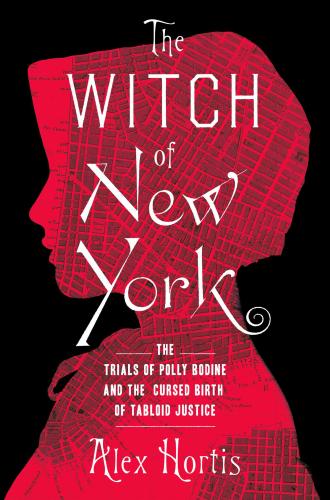Before the sensational cases of Amanda Knox and Casey Anthony—before even Lizzie Borden—there was Polly Bodine, the first American woman put on trial for capital murder in our nation’s debut media circus.
On Christmas night, December 25, 1843, in a serene village on Staten Island, shocked neighbors discovered the burnt remains of twenty-four-year-old mother Emeline Houseman and her infant daughter, Ann Eliza. In a perverse nativity, someone bludgeoned to death a mother and child in their home—and then covered up the crime with hellfire.
When an ambitious district attorney charges Polly Bodine (Emelin’s sister-in-law) with a double homicide, the new “penny press” explodes. Polly is a perfect media villain: she’s a separated wife who drinks gin, commits adultery, and has had multiple abortions. Between June 1844 and April 1846, the nation was enthralled by her three trials—in Staten Island, Manhattan, and Newburgh—for the “Christmas murders.”
After Polly’s legal dream team entered the fray, the press and the public debated not only her guilt, but her character and fate as a fallen woman in society. Public opinion split into different camps over her case. Edgar Allen Poe and Walt Whitman covered her case as young newsmen. P. T. Barnum made a circus out of it. James Fenimore Cooper’s last novel was inspired by her trials.
The Witch of New York is the first narrative history about the dueling trial lawyers, ruthless newsmen, and shameless hucksters who turned the Polly Bodine case into America’s formative tabloid trial. An origin story of how America became addicted to sensationalized reporting of criminal trials, The Witch of New York vividly reconstructs an epic mystery from Old New York—and uses the Bodine case to challenge our system of tabloid justice of today.
On Christmas night, December 25, 1843, in a serene village on Staten Island, shocked neighbors discovered the burnt remains of twenty-four-year-old mother Emeline Houseman and her infant daughter, Ann Eliza. In a perverse nativity, someone bludgeoned to death a mother and child in their home—and then covered up the crime with hellfire.
When an ambitious district attorney charges Polly Bodine (Emelin’s sister-in-law) with a double homicide, the new “penny press” explodes. Polly is a perfect media villain: she’s a separated wife who drinks gin, commits adultery, and has had multiple abortions. Between June 1844 and April 1846, the nation was enthralled by her three trials—in Staten Island, Manhattan, and Newburgh—for the “Christmas murders.”
After Polly’s legal dream team entered the fray, the press and the public debated not only her guilt, but her character and fate as a fallen woman in society. Public opinion split into different camps over her case. Edgar Allen Poe and Walt Whitman covered her case as young newsmen. P. T. Barnum made a circus out of it. James Fenimore Cooper’s last novel was inspired by her trials.
The Witch of New York is the first narrative history about the dueling trial lawyers, ruthless newsmen, and shameless hucksters who turned the Polly Bodine case into America’s formative tabloid trial. An origin story of how America became addicted to sensationalized reporting of criminal trials, The Witch of New York vividly reconstructs an epic mystery from Old New York—and uses the Bodine case to challenge our system of tabloid justice of today.
Review Quotes
“The Witch of New York reconstructs the events and subsequent trials [of Polly Bodine] in great detail. It is an engaging story, skillfully told. To read The Witch of New York is to understand the ancestry of the current true-crime craze.”
“A compulsively readable book. Emphasizes the deep misogynist roots of witch trials, real and metaphorical, and belong firmly within the contemporary examination of the United States’ ongoing and multifaceted satanic panic.”
“In The Witch of New York, Alex Hortis invites us along on a bumpy yet entertaining ride that features the dueling attorneys and unscrupulous shysters who transformed the terrible murder of a mother and child into this country's seminal tabloid trial. Meticulous research and concise writing adroitly capture the zeitgeist of 1840s New York City, in the end effectively demonstrating how "tabloid justice would, one way or another, alter American law."
“A riveting true crime story from history, Alex Hortis’s The Witch of New York chronicles the misogynist frenzy surrounding a notorious murder trial.”
“In this excellent work of true crime, Hortis examines the case of Polly Bodine, who became infamous after she was accused of murdering her sister-in-law and infant niece. Hortis’s historical detail makes the episode come to life, and he successfully evokes contemporary tabloid scandals like the Amanda Knox trial. Fans of Daniel Stashower will love this.”
“A fascinating look at the crime and what came after. Hortis covers the material with workmanlike efficiency and a keen eye for courtroom theatrics. As quaint as some of the story’s details may seem, its themes feel remarkably contemporary: We still rush to judgment, resort to stereotyping and fall for all kinds of propaganda. It’s impossible to argue with the book’s thesis: ‘Tabloid justice would, one way or another, alter American law.’”
"Through meticulous reconstruction and vivid storytelling, Hortis delves into the depths of the Polly Bodine case, illuminating the shadows of suspicion and scandal that surrounded it."
“Against a backdrop of scandal sheets and tabloid justice in 1840s New York, Alex Hortis deftly chronicles the sensational murder trials of Polly Bodine, the most infamous woman in America, and their lasting effects on the public’s imagination.”
“A lively history of early New York through one woman’s horrendous ordeal. Hortis has combed the archives for material related to Bodine’s three explosive trials, and he makes palpable the shameful character assassination that Bodine endured.”

